Comprehensive Analysis of Business Model Concepts and Strategies
VerifiedAdded on 2020/02/24
|9
|2192
|88
Essay
AI Summary
This essay provides a comprehensive overview of the business model concept, emphasizing its crucial role in planning and executing business strategies. It defines the business model as a synopsis of an organization's operations, encompassing value creation, capture, and delivery across economic, cultural, and societal dimensions. The essay delves into the fundamental business model archetypes, including product, service, trade, brokerage, subscription, marketplace, and ecosystem models, highlighting their importance in designing effective business strategies. It also discusses key components like revenue architecture and the activity system, which defines the internal dependencies of business activities. Furthermore, the essay addresses the business model's problem-solving capabilities, both static and dynamic, and its ability to adapt to the changing market environment. The concept of business context and the impact of big data are also explored, using Capgemini as an example of how big data integration can drive revenue growth and stakeholder engagement. The essay concludes by emphasizing the need for a clear understanding of business objectives, market dynamics, and the significance of change in a global business setting.
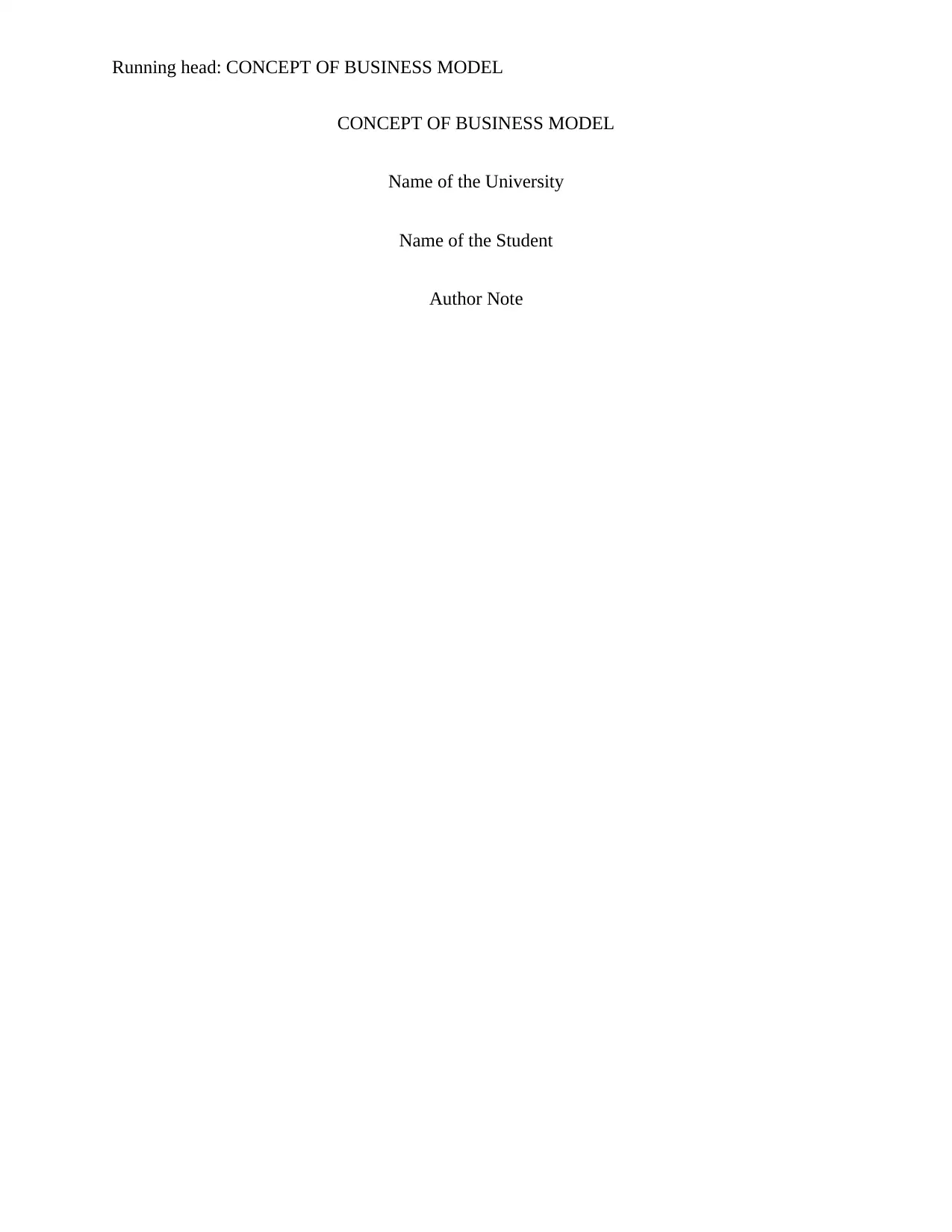
Running head: CONCEPT OF BUSINESS MODEL
CONCEPT OF BUSINESS MODEL
Name of the University
Name of the Student
Author Note
CONCEPT OF BUSINESS MODEL
Name of the University
Name of the Student
Author Note
Paraphrase This Document
Need a fresh take? Get an instant paraphrase of this document with our AI Paraphraser
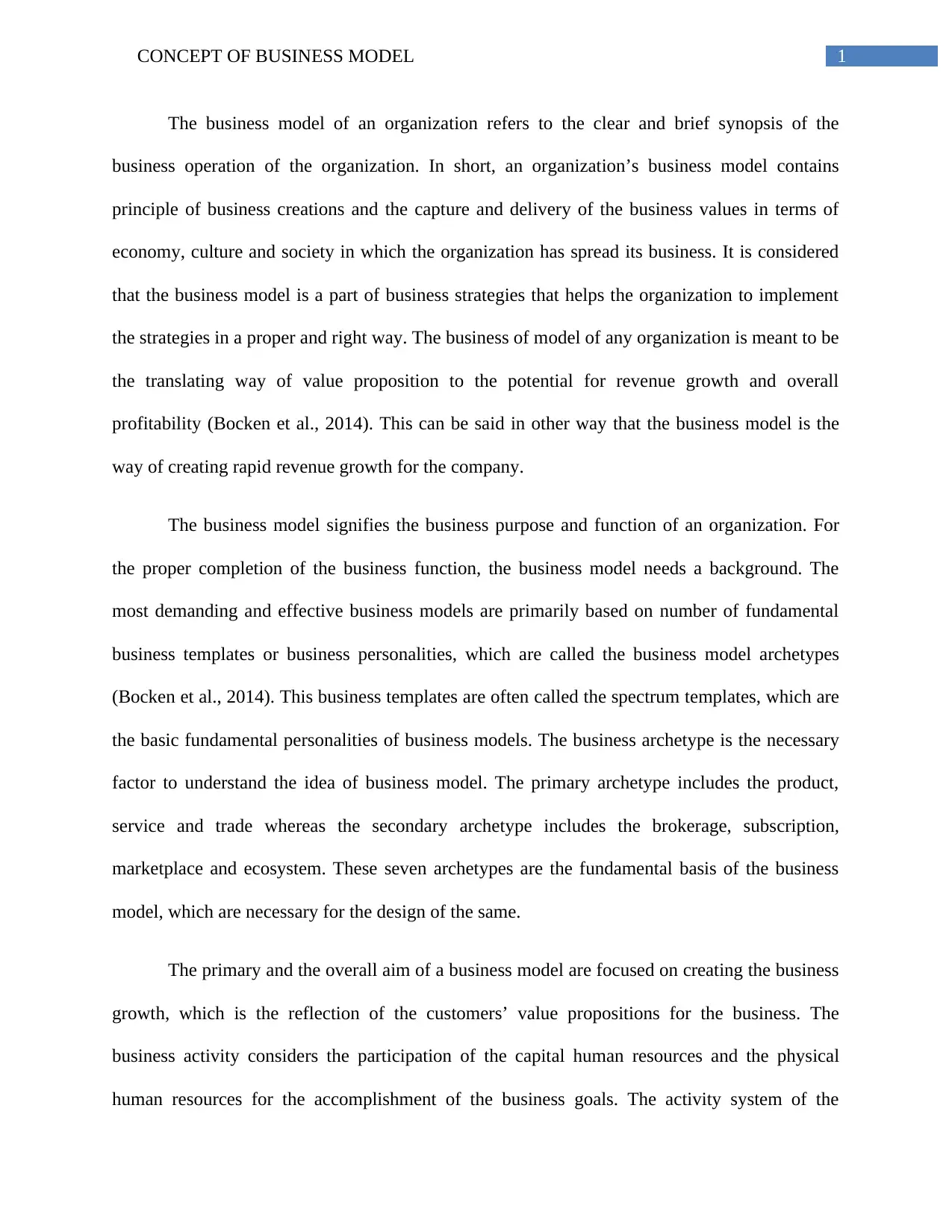
1CONCEPT OF BUSINESS MODEL
The business model of an organization refers to the clear and brief synopsis of the
business operation of the organization. In short, an organization’s business model contains
principle of business creations and the capture and delivery of the business values in terms of
economy, culture and society in which the organization has spread its business. It is considered
that the business model is a part of business strategies that helps the organization to implement
the strategies in a proper and right way. The business of model of any organization is meant to be
the translating way of value proposition to the potential for revenue growth and overall
profitability (Bocken et al., 2014). This can be said in other way that the business model is the
way of creating rapid revenue growth for the company.
The business model signifies the business purpose and function of an organization. For
the proper completion of the business function, the business model needs a background. The
most demanding and effective business models are primarily based on number of fundamental
business templates or business personalities, which are called the business model archetypes
(Bocken et al., 2014). This business templates are often called the spectrum templates, which are
the basic fundamental personalities of business models. The business archetype is the necessary
factor to understand the idea of business model. The primary archetype includes the product,
service and trade whereas the secondary archetype includes the brokerage, subscription,
marketplace and ecosystem. These seven archetypes are the fundamental basis of the business
model, which are necessary for the design of the same.
The primary and the overall aim of a business model are focused on creating the business
growth, which is the reflection of the customers’ value propositions for the business. The
business activity considers the participation of the capital human resources and the physical
human resources for the accomplishment of the business goals. The activity system of the
The business model of an organization refers to the clear and brief synopsis of the
business operation of the organization. In short, an organization’s business model contains
principle of business creations and the capture and delivery of the business values in terms of
economy, culture and society in which the organization has spread its business. It is considered
that the business model is a part of business strategies that helps the organization to implement
the strategies in a proper and right way. The business of model of any organization is meant to be
the translating way of value proposition to the potential for revenue growth and overall
profitability (Bocken et al., 2014). This can be said in other way that the business model is the
way of creating rapid revenue growth for the company.
The business model signifies the business purpose and function of an organization. For
the proper completion of the business function, the business model needs a background. The
most demanding and effective business models are primarily based on number of fundamental
business templates or business personalities, which are called the business model archetypes
(Bocken et al., 2014). This business templates are often called the spectrum templates, which are
the basic fundamental personalities of business models. The business archetype is the necessary
factor to understand the idea of business model. The primary archetype includes the product,
service and trade whereas the secondary archetype includes the brokerage, subscription,
marketplace and ecosystem. These seven archetypes are the fundamental basis of the business
model, which are necessary for the design of the same.
The primary and the overall aim of a business model are focused on creating the business
growth, which is the reflection of the customers’ value propositions for the business. The
business activity considers the participation of the capital human resources and the physical
human resources for the accomplishment of the business goals. The activity system of the

2CONCEPT OF BUSINESS MODEL
business model intents the internally dependent range of organizational activities around the
organization. The activities of the business determinates such as customers, stakeholders, firm
and the partners of the firm are executed by the activity system of business. The central concept
of the activity system presents the internal dependency of the business activities by the different
components responsible for the same (Bocken et al., 2016). A clear and precise picture is
reflected through the interdependencies of the business activities, which are the result of the
evolution process of the organization. The evolution process covers the duration of sustainability
of the business and the expansion of the business boundaries in the competitive and constant
changing market (Schaltegger, Lüdeke-Freund & Hansen, 2012). The potential customers,
suppliers and the stakeholders are defined by the activity system of the business.
Revenue architecture is one of the basic components integrated into the business model.
The pricing strategies and revenue growth of the business are referred by the cost revenue
architecture of the business model. This revenue architectural business model generates cost
revenue of the business and consequently the business model and revenue architecture are
internally connected with each other (Schaltegger, Lüdeke-Freund & Hansen, 2012). Moreover,
the cost revenue models and the business model are complementary to each other in terms of
determining the pricing and designing strategies of the product or the service provided by the
firm. The ‘razor-blade model’ is one of the popular cost effective revenue architecture models
that include the inexpensive pricing razor and marking up of the consumables (Baden-Fuller &
Haefliger, 2013). Precisely, the business model and the revenue model are interdependent in
terms of generating the cost revenue for the business.
The business model of an organization includes the capabilities of problem solving. The
business model solves the static and dynamic problems inherited from the organization’s
business model intents the internally dependent range of organizational activities around the
organization. The activities of the business determinates such as customers, stakeholders, firm
and the partners of the firm are executed by the activity system of business. The central concept
of the activity system presents the internal dependency of the business activities by the different
components responsible for the same (Bocken et al., 2016). A clear and precise picture is
reflected through the interdependencies of the business activities, which are the result of the
evolution process of the organization. The evolution process covers the duration of sustainability
of the business and the expansion of the business boundaries in the competitive and constant
changing market (Schaltegger, Lüdeke-Freund & Hansen, 2012). The potential customers,
suppliers and the stakeholders are defined by the activity system of the business.
Revenue architecture is one of the basic components integrated into the business model.
The pricing strategies and revenue growth of the business are referred by the cost revenue
architecture of the business model. This revenue architectural business model generates cost
revenue of the business and consequently the business model and revenue architecture are
internally connected with each other (Schaltegger, Lüdeke-Freund & Hansen, 2012). Moreover,
the cost revenue models and the business model are complementary to each other in terms of
determining the pricing and designing strategies of the product or the service provided by the
firm. The ‘razor-blade model’ is one of the popular cost effective revenue architecture models
that include the inexpensive pricing razor and marking up of the consumables (Baden-Fuller &
Haefliger, 2013). Precisely, the business model and the revenue model are interdependent in
terms of generating the cost revenue for the business.
The business model of an organization includes the capabilities of problem solving. The
business model solves the static and dynamic problems inherited from the organization’s
⊘ This is a preview!⊘
Do you want full access?
Subscribe today to unlock all pages.

Trusted by 1+ million students worldwide
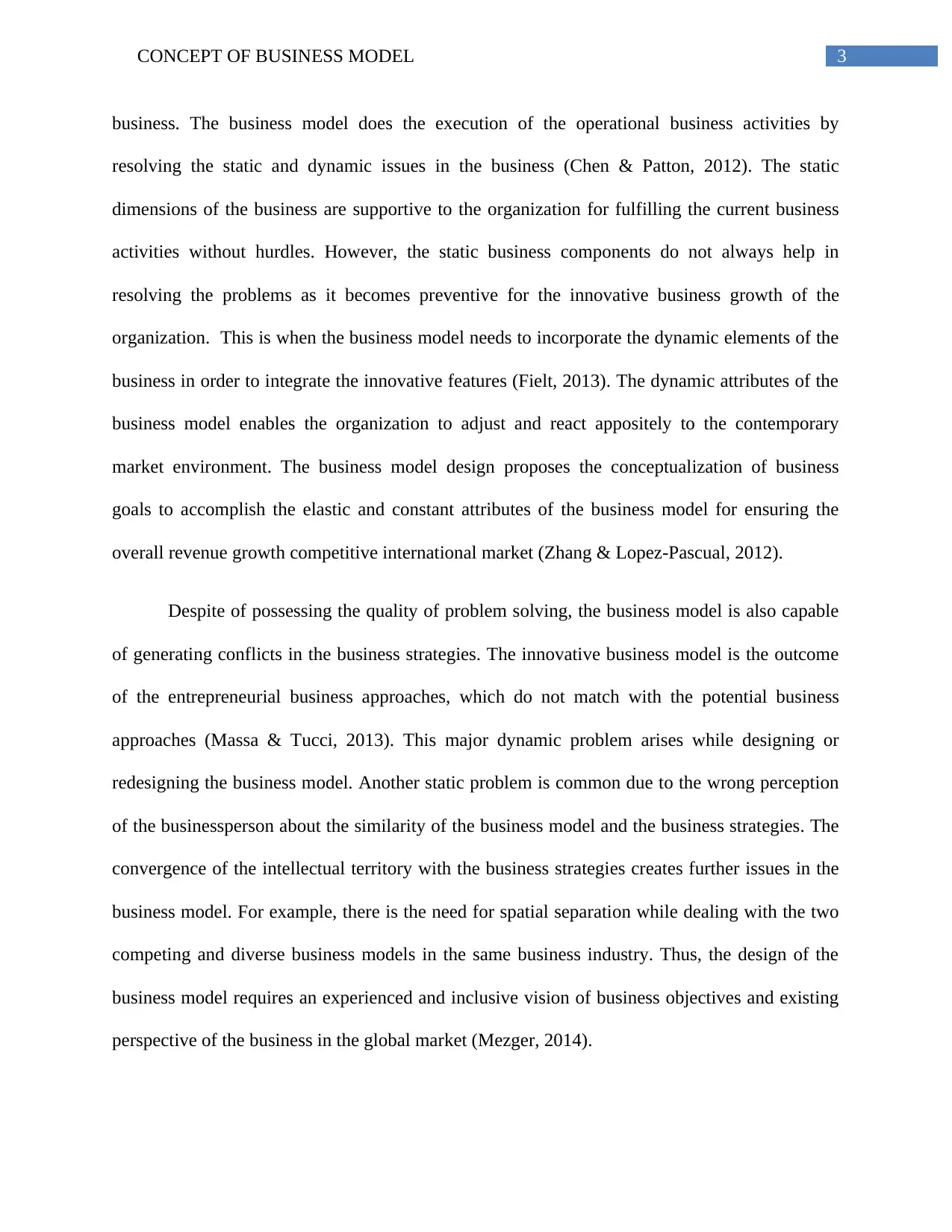
3CONCEPT OF BUSINESS MODEL
business. The business model does the execution of the operational business activities by
resolving the static and dynamic issues in the business (Chen & Patton, 2012). The static
dimensions of the business are supportive to the organization for fulfilling the current business
activities without hurdles. However, the static business components do not always help in
resolving the problems as it becomes preventive for the innovative business growth of the
organization. This is when the business model needs to incorporate the dynamic elements of the
business in order to integrate the innovative features (Fielt, 2013). The dynamic attributes of the
business model enables the organization to adjust and react appositely to the contemporary
market environment. The business model design proposes the conceptualization of business
goals to accomplish the elastic and constant attributes of the business model for ensuring the
overall revenue growth competitive international market (Zhang & Lopez-Pascual, 2012).
Despite of possessing the quality of problem solving, the business model is also capable
of generating conflicts in the business strategies. The innovative business model is the outcome
of the entrepreneurial business approaches, which do not match with the potential business
approaches (Massa & Tucci, 2013). This major dynamic problem arises while designing or
redesigning the business model. Another static problem is common due to the wrong perception
of the businessperson about the similarity of the business model and the business strategies. The
convergence of the intellectual territory with the business strategies creates further issues in the
business model. For example, there is the need for spatial separation while dealing with the two
competing and diverse business models in the same business industry. Thus, the design of the
business model requires an experienced and inclusive vision of business objectives and existing
perspective of the business in the global market (Mezger, 2014).
business. The business model does the execution of the operational business activities by
resolving the static and dynamic issues in the business (Chen & Patton, 2012). The static
dimensions of the business are supportive to the organization for fulfilling the current business
activities without hurdles. However, the static business components do not always help in
resolving the problems as it becomes preventive for the innovative business growth of the
organization. This is when the business model needs to incorporate the dynamic elements of the
business in order to integrate the innovative features (Fielt, 2013). The dynamic attributes of the
business model enables the organization to adjust and react appositely to the contemporary
market environment. The business model design proposes the conceptualization of business
goals to accomplish the elastic and constant attributes of the business model for ensuring the
overall revenue growth competitive international market (Zhang & Lopez-Pascual, 2012).
Despite of possessing the quality of problem solving, the business model is also capable
of generating conflicts in the business strategies. The innovative business model is the outcome
of the entrepreneurial business approaches, which do not match with the potential business
approaches (Massa & Tucci, 2013). This major dynamic problem arises while designing or
redesigning the business model. Another static problem is common due to the wrong perception
of the businessperson about the similarity of the business model and the business strategies. The
convergence of the intellectual territory with the business strategies creates further issues in the
business model. For example, there is the need for spatial separation while dealing with the two
competing and diverse business models in the same business industry. Thus, the design of the
business model requires an experienced and inclusive vision of business objectives and existing
perspective of the business in the global market (Mezger, 2014).
Paraphrase This Document
Need a fresh take? Get an instant paraphrase of this document with our AI Paraphraser

4CONCEPT OF BUSINESS MODEL
The concept of the business context denotes such a context where the entire business
community is employed. The business context is the basis of business community or the
specialized business vocabulary. In addition, the prime and constant notion of the business
context is change. Change is the constant factor of the business as the business values and the
approaches in the global business market is rapidly changing with the pace of time. The needs
for the new innovative business ideas, digitalization, and the new people are resulting into the
‘rise of big data’. The concept of big data signifies the business interruption and impacts
increasingly effective result on the stakeholders of the firm. For example, the big data is
projecting turbulent influence on the market. One of the major information technology
companies, namely Capgemini has taken the initiatives to include the big data business model
into the company for the effective involvement of the nontraditional stakeholders (Wielki, 2013).
For obtaining the business objectives, the company is designing their business models centered
on big data to ensure the value proposition of the business.
After the implementation and execution of the business model based on big data the
failure rate of the company has been decreased and the success rate has been increased
respectively (Katal, Wazid & Goudar, 2013). The prime focal point of the managers of the
organization is the efficient staffs and innovative technologies, as the skilled people and the
technological advancement are the basic requirement of the big data. The rapid and the cost
effective growth of the organization is based on the big data as well as the clear insight of the
managers regarding the same.
The above discourse concludes the concept of the business model is and its
implementation is one of the basic units in the business. The aim and function of the business
model is to plan the business strategies along with balancing various business activities
The concept of the business context denotes such a context where the entire business
community is employed. The business context is the basis of business community or the
specialized business vocabulary. In addition, the prime and constant notion of the business
context is change. Change is the constant factor of the business as the business values and the
approaches in the global business market is rapidly changing with the pace of time. The needs
for the new innovative business ideas, digitalization, and the new people are resulting into the
‘rise of big data’. The concept of big data signifies the business interruption and impacts
increasingly effective result on the stakeholders of the firm. For example, the big data is
projecting turbulent influence on the market. One of the major information technology
companies, namely Capgemini has taken the initiatives to include the big data business model
into the company for the effective involvement of the nontraditional stakeholders (Wielki, 2013).
For obtaining the business objectives, the company is designing their business models centered
on big data to ensure the value proposition of the business.
After the implementation and execution of the business model based on big data the
failure rate of the company has been decreased and the success rate has been increased
respectively (Katal, Wazid & Goudar, 2013). The prime focal point of the managers of the
organization is the efficient staffs and innovative technologies, as the skilled people and the
technological advancement are the basic requirement of the big data. The rapid and the cost
effective growth of the organization is based on the big data as well as the clear insight of the
managers regarding the same.
The above discourse concludes the concept of the business model is and its
implementation is one of the basic units in the business. The aim and function of the business
model is to plan the business strategies along with balancing various business activities

5CONCEPT OF BUSINESS MODEL
performed by the variables of the organization. The business model also influences the revenue
growth of the business and resolves various static and dynamic problems of the firm. The essay
presents the business context and the notion of change as the constant factor of the business that
is capable of influencing the business in the global aspect. The result of the constant changing
values leads the organization to redesign their business model using the big data, which
effectively ensures the business growth.
performed by the variables of the organization. The business model also influences the revenue
growth of the business and resolves various static and dynamic problems of the firm. The essay
presents the business context and the notion of change as the constant factor of the business that
is capable of influencing the business in the global aspect. The result of the constant changing
values leads the organization to redesign their business model using the big data, which
effectively ensures the business growth.
⊘ This is a preview!⊘
Do you want full access?
Subscribe today to unlock all pages.

Trusted by 1+ million students worldwide
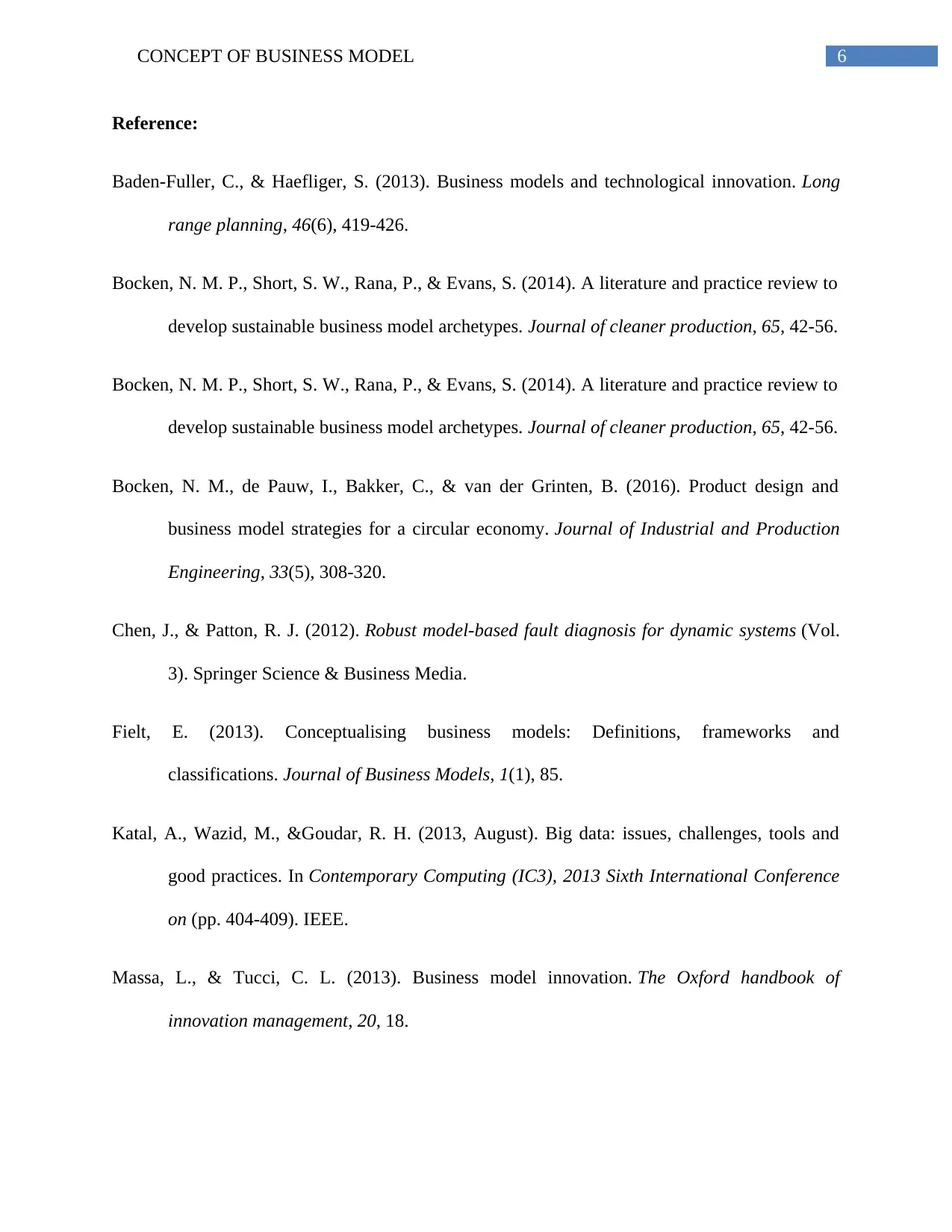
6CONCEPT OF BUSINESS MODEL
Reference:
Baden-Fuller, C., & Haefliger, S. (2013). Business models and technological innovation. Long
range planning, 46(6), 419-426.
Bocken, N. M. P., Short, S. W., Rana, P., & Evans, S. (2014). A literature and practice review to
develop sustainable business model archetypes. Journal of cleaner production, 65, 42-56.
Bocken, N. M. P., Short, S. W., Rana, P., & Evans, S. (2014). A literature and practice review to
develop sustainable business model archetypes. Journal of cleaner production, 65, 42-56.
Bocken, N. M., de Pauw, I., Bakker, C., & van der Grinten, B. (2016). Product design and
business model strategies for a circular economy. Journal of Industrial and Production
Engineering, 33(5), 308-320.
Chen, J., & Patton, R. J. (2012). Robust model-based fault diagnosis for dynamic systems (Vol.
3). Springer Science & Business Media.
Fielt, E. (2013). Conceptualising business models: Definitions, frameworks and
classifications. Journal of Business Models, 1(1), 85.
Katal, A., Wazid, M., &Goudar, R. H. (2013, August). Big data: issues, challenges, tools and
good practices. In Contemporary Computing (IC3), 2013 Sixth International Conference
on (pp. 404-409). IEEE.
Massa, L., & Tucci, C. L. (2013). Business model innovation. The Oxford handbook of
innovation management, 20, 18.
Reference:
Baden-Fuller, C., & Haefliger, S. (2013). Business models and technological innovation. Long
range planning, 46(6), 419-426.
Bocken, N. M. P., Short, S. W., Rana, P., & Evans, S. (2014). A literature and practice review to
develop sustainable business model archetypes. Journal of cleaner production, 65, 42-56.
Bocken, N. M. P., Short, S. W., Rana, P., & Evans, S. (2014). A literature and practice review to
develop sustainable business model archetypes. Journal of cleaner production, 65, 42-56.
Bocken, N. M., de Pauw, I., Bakker, C., & van der Grinten, B. (2016). Product design and
business model strategies for a circular economy. Journal of Industrial and Production
Engineering, 33(5), 308-320.
Chen, J., & Patton, R. J. (2012). Robust model-based fault diagnosis for dynamic systems (Vol.
3). Springer Science & Business Media.
Fielt, E. (2013). Conceptualising business models: Definitions, frameworks and
classifications. Journal of Business Models, 1(1), 85.
Katal, A., Wazid, M., &Goudar, R. H. (2013, August). Big data: issues, challenges, tools and
good practices. In Contemporary Computing (IC3), 2013 Sixth International Conference
on (pp. 404-409). IEEE.
Massa, L., & Tucci, C. L. (2013). Business model innovation. The Oxford handbook of
innovation management, 20, 18.
Paraphrase This Document
Need a fresh take? Get an instant paraphrase of this document with our AI Paraphraser
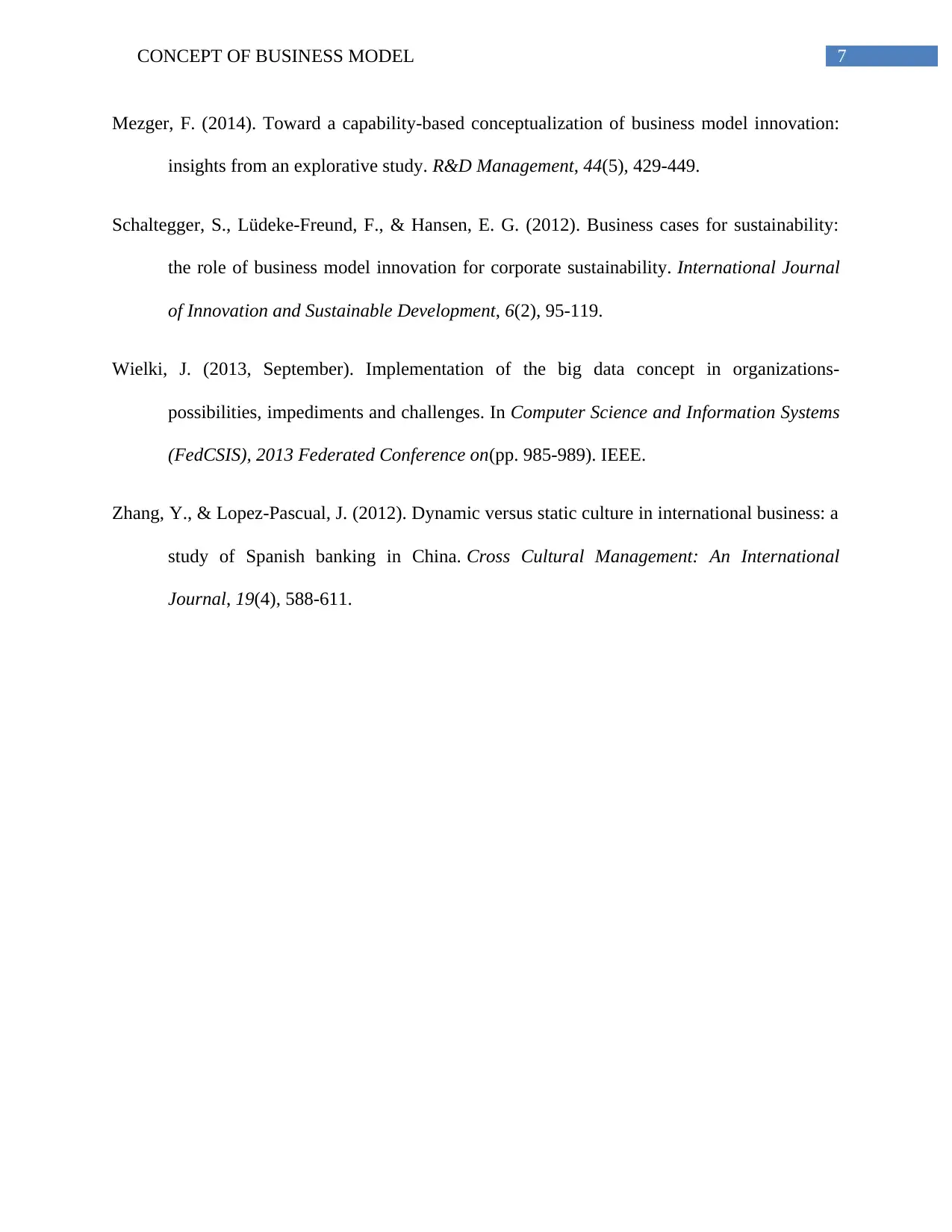
7CONCEPT OF BUSINESS MODEL
Mezger, F. (2014). Toward a capability‐based conceptualization of business model innovation:
insights from an explorative study. R&D Management, 44(5), 429-449.
Schaltegger, S., Lüdeke-Freund, F., & Hansen, E. G. (2012). Business cases for sustainability:
the role of business model innovation for corporate sustainability. International Journal
of Innovation and Sustainable Development, 6(2), 95-119.
Wielki, J. (2013, September). Implementation of the big data concept in organizations-
possibilities, impediments and challenges. In Computer Science and Information Systems
(FedCSIS), 2013 Federated Conference on(pp. 985-989). IEEE.
Zhang, Y., & Lopez-Pascual, J. (2012). Dynamic versus static culture in international business: a
study of Spanish banking in China. Cross Cultural Management: An International
Journal, 19(4), 588-611.
Mezger, F. (2014). Toward a capability‐based conceptualization of business model innovation:
insights from an explorative study. R&D Management, 44(5), 429-449.
Schaltegger, S., Lüdeke-Freund, F., & Hansen, E. G. (2012). Business cases for sustainability:
the role of business model innovation for corporate sustainability. International Journal
of Innovation and Sustainable Development, 6(2), 95-119.
Wielki, J. (2013, September). Implementation of the big data concept in organizations-
possibilities, impediments and challenges. In Computer Science and Information Systems
(FedCSIS), 2013 Federated Conference on(pp. 985-989). IEEE.
Zhang, Y., & Lopez-Pascual, J. (2012). Dynamic versus static culture in international business: a
study of Spanish banking in China. Cross Cultural Management: An International
Journal, 19(4), 588-611.
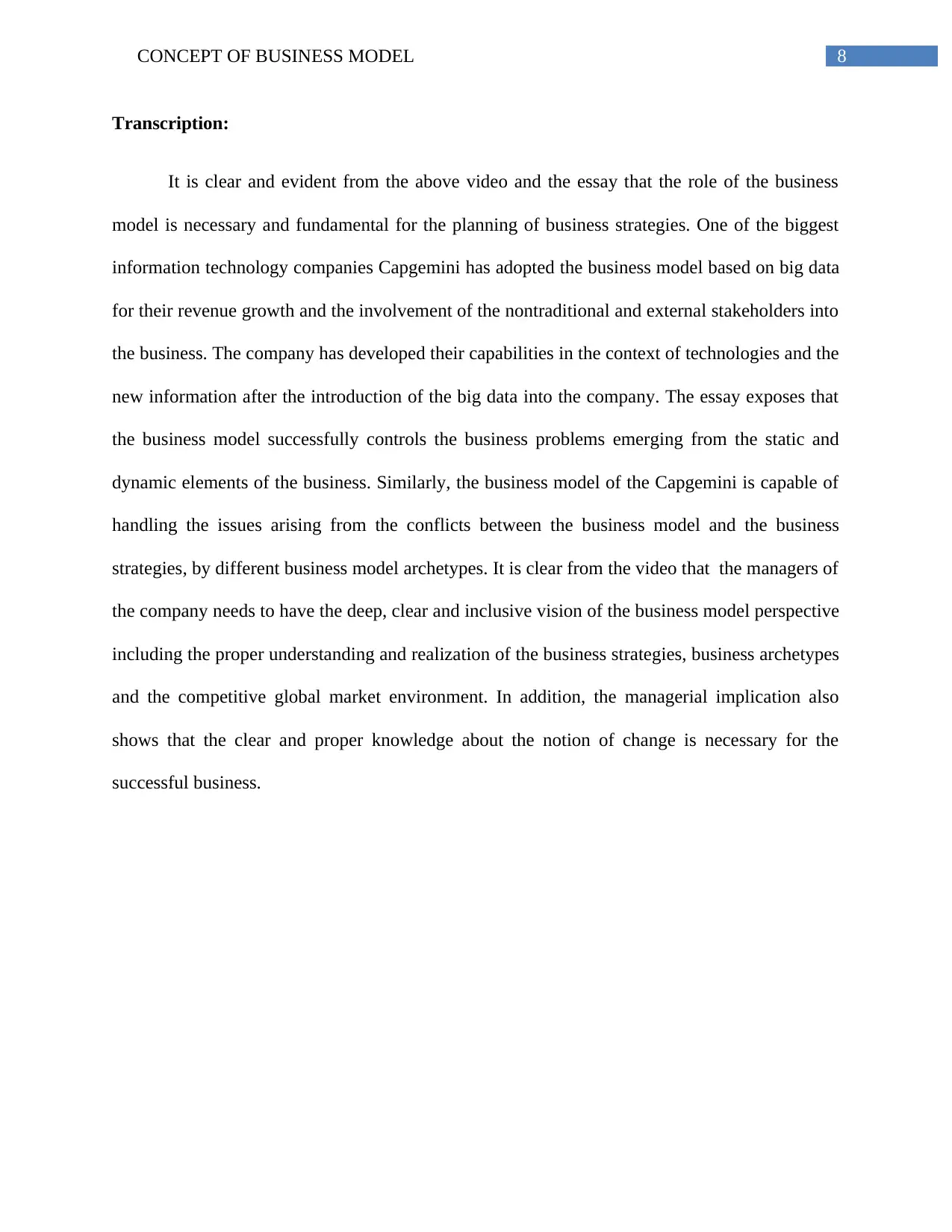
8CONCEPT OF BUSINESS MODEL
Transcription:
It is clear and evident from the above video and the essay that the role of the business
model is necessary and fundamental for the planning of business strategies. One of the biggest
information technology companies Capgemini has adopted the business model based on big data
for their revenue growth and the involvement of the nontraditional and external stakeholders into
the business. The company has developed their capabilities in the context of technologies and the
new information after the introduction of the big data into the company. The essay exposes that
the business model successfully controls the business problems emerging from the static and
dynamic elements of the business. Similarly, the business model of the Capgemini is capable of
handling the issues arising from the conflicts between the business model and the business
strategies, by different business model archetypes. It is clear from the video that the managers of
the company needs to have the deep, clear and inclusive vision of the business model perspective
including the proper understanding and realization of the business strategies, business archetypes
and the competitive global market environment. In addition, the managerial implication also
shows that the clear and proper knowledge about the notion of change is necessary for the
successful business.
Transcription:
It is clear and evident from the above video and the essay that the role of the business
model is necessary and fundamental for the planning of business strategies. One of the biggest
information technology companies Capgemini has adopted the business model based on big data
for their revenue growth and the involvement of the nontraditional and external stakeholders into
the business. The company has developed their capabilities in the context of technologies and the
new information after the introduction of the big data into the company. The essay exposes that
the business model successfully controls the business problems emerging from the static and
dynamic elements of the business. Similarly, the business model of the Capgemini is capable of
handling the issues arising from the conflicts between the business model and the business
strategies, by different business model archetypes. It is clear from the video that the managers of
the company needs to have the deep, clear and inclusive vision of the business model perspective
including the proper understanding and realization of the business strategies, business archetypes
and the competitive global market environment. In addition, the managerial implication also
shows that the clear and proper knowledge about the notion of change is necessary for the
successful business.
⊘ This is a preview!⊘
Do you want full access?
Subscribe today to unlock all pages.

Trusted by 1+ million students worldwide
1 out of 9
Related Documents
Your All-in-One AI-Powered Toolkit for Academic Success.
+13062052269
info@desklib.com
Available 24*7 on WhatsApp / Email
![[object Object]](/_next/static/media/star-bottom.7253800d.svg)
Unlock your academic potential
Copyright © 2020–2025 A2Z Services. All Rights Reserved. Developed and managed by ZUCOL.





